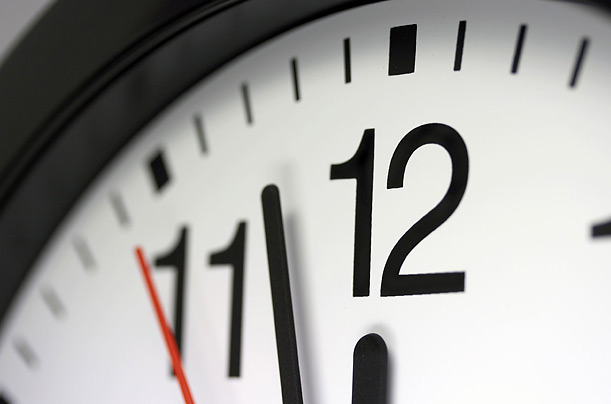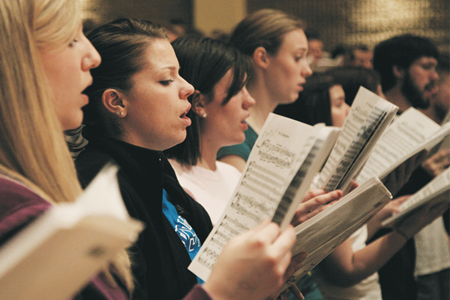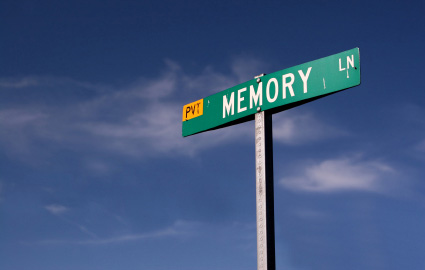Time…the great equalizer. We have all been given 24 hours in a day. The difference between all of us is how we use those precious hours.
The position of music minister and/or choral director requires a keen sense of time. We are bound by the clock, whether it is during a worship service, meeting, or a rehearsal. We are given a certain number of minutes with which we inspire, challenge, encourage, uplift, and, simply, lead individuals. Minutes are precious, and as we all know, we cannot recover squandered time. We are charged with the biblical mandate to be good stewards of our gifts as well as those in the ministries we lead. We are to develop, sharpen, and refine those individuals’ gifts and skills. It is a high and worthy calling, and it takes time—time that should be well spent, carefully guarded, and thoughtfully planned.
Consider your rehearsal. Let’s take a short quiz so you can get a baseline for your time management in rehearsal.
1. On average, do your rehearsals start on time? Do they end on time?
2. Do you have a rehearsal plan with an estimated time for how long you will spend on each piece?
3. On average, does your rehearsal plan unfold as you expected or are you always making adjustments “on the fly?”
4. On average, when you get to the end of a rehearsal, did you get to everything you wanted or did you have to skip several things?
5. On average, does the time seem to drag on or fly by?
Armed with these answers, I want to offer a few principles that I have found to be quite helpful for managing my rehearsals and getting the most out of my rehearsal minutes. I think of this discussion as a mixture of rehearsal technique and rehearsal pacing.
1. Have a rehearsal plan. This sounds obvious, even the most seasoned directors have a plan of attack before beginning a rehearsal. I like to list the time of the rehearsal where I plan to start working a certain piece. For example, if my rehearsal starts at 4:30, my rehearsal plan might look like this:
Gathering/welcome/prayer – 4:30
Warm-ups – 4:35
Arise, Shine – 4:45
God is Our Refuge and Strength – 4:55
Glory to God – 5:05
Etc.
2. Don’t spend more than 10% of your time on warm-ups, if you do any. (I hope you do some type of warm-up.) Be intentional about this time and plan it out. Don’t always do the same thing. Use a variety of warm-ups to keep it fresh. There are tons of resources in this area. Find a book/video online and buy it for your personal library.
3. Give your accompanist(s) the rehearsal order and post it on the board/screen, but don’t be afraid to veer from it. Either way, it gives the rehearsal a sense of purpose and intentionality. Singers will see there is much to be done within the given time frame. It helps them share in the success of the rehearsal.
4. Generally, I do not like to spend more than 10-15 minutes on any piece. For students I like to keep it to 10-12 minutes. I don’t care what it is I’m doing, whether it’s notes and rhythms, polishing a section, working transitions, memorizing, etc. To go longer than this makes the rehearsal bog down and drains your singers mentally. Know exactly what you want to accomplish for a specific piece and go for that. Don’t start at the beginning if you are rehearsing something in the middle or end.
5. Generally, start and end the rehearsal with something familiar or something they know very well. It helps them get acclimated and gives them a sense of accomplishment as they leave.
6. Do not put off learning something brand new to the very end of rehearsal. This needs to be done in the middle. If several pieces are new or still in the early stages, try to break them up with things that are more familiar.
7. Another helpful pedagogical approach is the idea of the hourglass. The top and bottom of the hourglass are very wide, and they represent the “general” or broad scope learning that happens in a rehearsal. This might include introducing new music, working large sections, pounding out notes and rhythms, etc. These pieces are in the building block stages. In contrast, the middle of the hourglass is very narrow, representing a very “specific” or detailed approach in rehearsal. This might include working small sections of a piece, getting “picky,” or doing some detail work on a few pieces that have been “in the oven” for a while. The overall picture of the rehearsal looks like this:
G E N E R A L
specific
G E N E R A L
In fact, this concept can apply to how you teach an individual piece of music. You want to first give singers a broad/general understanding of the piece (read-through, establish nuts & bolts of the piece, work large sections) then move to working very specific sections, transitions, and other minutiae. But it is important to move back out to that broad understanding of the piece. It’s like moving from a bird’s eye view to using a microscope and then returning to the bird’s eye view.
8. In rehearsal, I like to move/walk around the room. Stand in front of the voice section that you are isolating. Have that section stand to sing those few bars, and then have them sit when finished. I have even walked on chairs up and down the rows of a section! It really gets their attention and it brings vibrancy to the rehearsal. If working multiple voice parts, have those sections stand and face each other across the room. Or, depending on how many rows you have, have students face each other within the section. For example, have the front row turn around and face the second row. I have found that, depending on your rehearsal space and choir size, it is also very helpful to get the sections to stand in a circle with an adult section leader standing in the middle. The section hears itself better, and your section leader can really provide immediate feedback and encouragement.
9. Keep the rehearsal moving. Know exactly where you want to go in the next piece in the rehearsal line-up. If you feel something is just not working or the energy level in the room is tanking, do not be afraid to “cut your losses.” Come back to the piece later if necessary, but don’t sacrifice the spirit of the rehearsal for one piece.
10.When stopping to fix a spot, go immediately to the issue. Don’t back up 8-10 measures before. Isolate the trouble spot, then go back 8-10 measures and put it in context. (specific to general).
11.When identifying problems for the choir to fix, they can really only process and implement (at maximum) about 3 corrective procedures. For example, a rhythm issue, a dynamic/expression issue, and a text/vowel issue. To pile on 5-6 things to fix is pointless and wastes time. The choir collectively will not fix any of them. Limit your corrective instructions to about 3 things, and the choir will retain the corrections better.
12.It is always better to give specific, ordered instructions for telling singers where to go in their music. Start with page number, followed by system (if necessary), then measure, and finally voice part (if isolating). Some directors even use this as a code, e.g., 10-3-4-bass = page 10, 3rd system, 4th measure, basses. It might sound extreme, but I have seen it be very effective. More simply, giving only page and measure would work, e.g. 10-82 = page 10, measure 82.
13.Talking too much. Video the rehearsal, and when you go back to watch it, have a timer in hand and start the timer every time you talk. Stop it when you are done talking. If you do this over through the entire rehearsal video, by the end you will see exactly how long you talked during rehearsal. It’s very telling, and sometimes painful. Proceed with caution.
14.If you accomplish your entire rehearsal plan and have time left, then end the rehearsal. I have found that ending 5 minutes early can earn me a great deal of “currency” and favor from my people. If they know I’m respectful of their time, then they will go even further for me in the future when I need to ask something extra of them.
Tick tock goes the clock.










